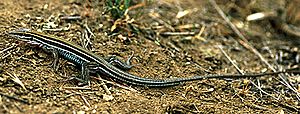Orange-throated whiptail facts for kids
Quick facts for kids Orange-throated whiptail |
|
|---|---|
 |
|
| Conservation status | |
| Scientific classification | |
| Genus: |
Aspidoscelis
|
| Species: |
hyperythrus
|
| Subspecies | |
|
|
The orange-throated whiptail (Aspidoscelis hyperythrus) is a type of lizard. It belongs to the Teiidae family, which includes many different kinds of whiptail lizards. This lizard was once part of a different group called Cnemidophorus. There are three main kinds, or subspecies, of the orange-throated whiptail that scientists recognize today.
Contents
Where Do Orange-throated Whiptails Live?
You can find the orange-throated whiptail in a few specific places. They live in southern California in the United States. They also make their home in the Mexican states of Baja California and Baja California Sur.
What Do Orange-throated Whiptails Look Like?
Orange-throated whiptails are easy to spot because of their unique colors. They have five or six light-colored stripes running down their backs. Their backs can be black, brown, or gray. Sometimes, the stripe in the middle might split at both ends.
Their bellies are usually whitish-yellow or cream. The most special part is their throat, which is often bright orange! However, young lizards and females might not have this orange throat. Their heads are yellowish-brown to olive green. These lizards have a tongue that is forked, like a snake's, and they flick it out all the time to sense their surroundings.
From their snout to the base of their tail, they are about 5 to 7.2 centimeters (2 to 2.8 inches) long. Young orange-throated whiptails are especially cool because their legs and tails are a bright cobalt blue! As males grow up, their entire underside, including their tail, can turn orange. Even some pregnant females might show some orange, especially around their lower jaw. These bright colors are usually strongest during their breeding season. Males also have larger femoral pores than females, which are small openings on their thighs.
How Do Orange-throated Whiptails Behave?
The orange-throated whiptail moves in a very special way. It has a jerky gait, which means it walks with quick, sudden movements. This unique way of moving helps them hunt and get around their habitat.
How Did They Get Their Name?
Some of the specific names for the different kinds of orange-throated whiptails honor important scientists. For example, the name beldingi is named after an American bird expert named Lyman Belding. The name schmidti honors another American scientist, Karl Patterson Schmidt, who studied reptiles and amphibians.


